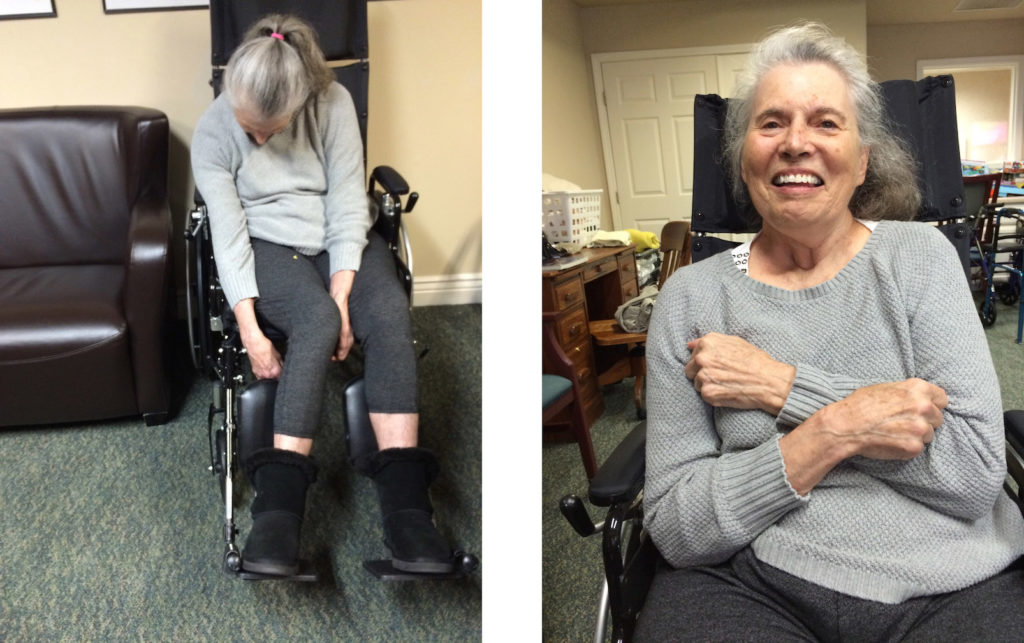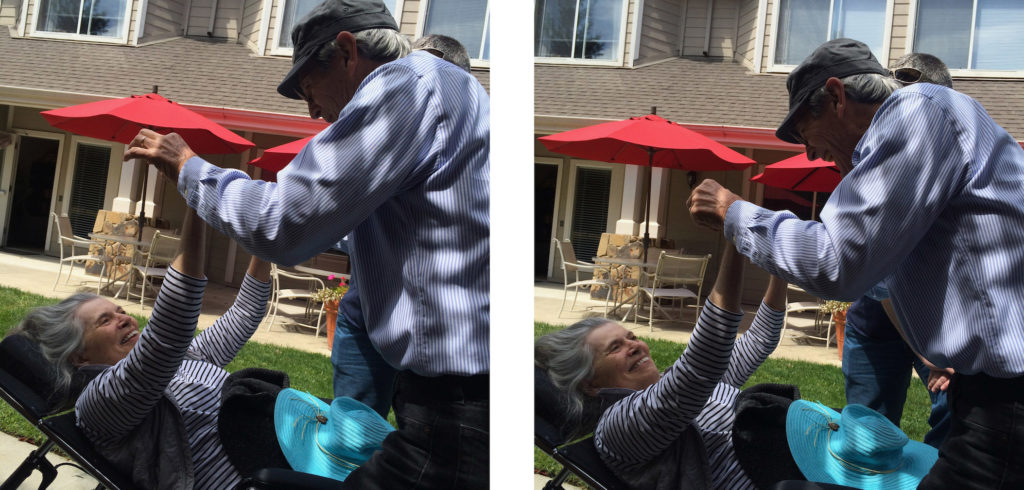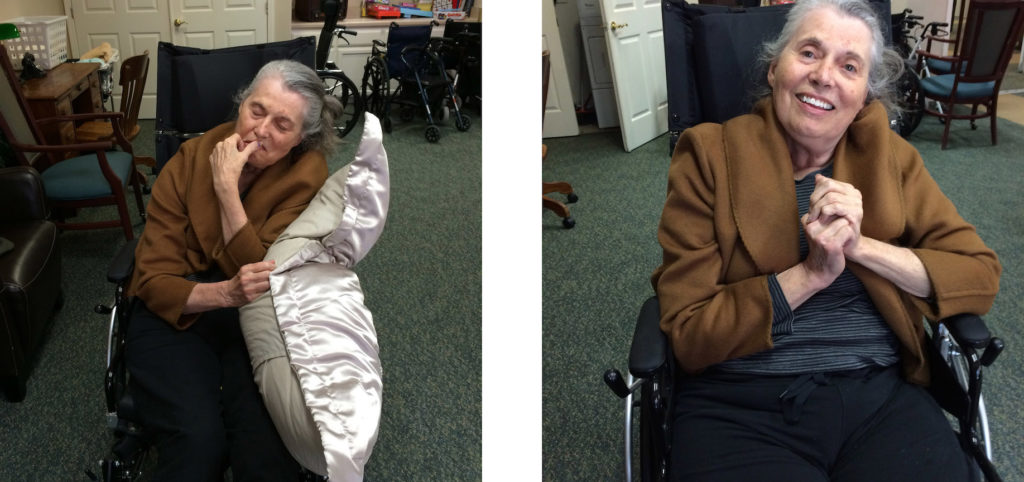Lisa was a gifted experimenter and my primary trial and error coach. When Leslie became too frustrated to read along with full pages of text, Lisa tried children’s books, photo books and magazines and noted which ones seemed to work better than others. Through trial and error, Lisa confirmed that when her mother pumped her hand up and down she was expressing excitement. Through similar efforts, she became astute in identifying what was likely to comfort or stress her her mom, and she passed tips about that on to other care givers and to Leslie’s doctors.
In addition to physical activities and overall care strategies, trial and error was an essential element of the conversations Lisa and I enjoyed with Leslie. If I saw she wasn’t interested in what I was talking about, I’d switch topics until I found one that caught her attention. If Lisa noticed Leslie’s attention fading while she was reading a magazine with her mom, she might pick up another magazine, or look for something good on TV. When either of us played Leslie music, we’d go through songs and genres until we found one or two that Leslie responded to, then play more of that for a while.
Trial and error approaches were helpful in addressing communication and assessment challenges for both care givers and visitors, and understandably so. Many residents lacked the language or attention skills to clarify for others their interests from one moment to the next–or to negotiate with visitors or care givers about shared activities. Like the rest us, the day-to-day experiences of residents also unfolded dynamically and recursively, with every moment setting terms by which the next could follow more or less agreeably. To work within the flow of a resident’s experiences for a given day, care givers and visitors had to assess where that flow was headed. Trial and error episodes were helpful in doing just that.
These improvised, small scale trial and error assessments reflected few if any standards of formal scientific experimentation. They were extremely valuable, however, in adjusting care strategies to the needs of individual memory care residents. Trial and error cycles were also useful to visitors and residents in negotiating how to spend time together and sustain their relationship from one visit to the next. In some instances, trial and error cycles also provided an existence proof for ideas or care practices that could improve quality of life for people living with Alzheimer’s or dementia. As one example, consider the photographs below.

The photo on the left was taken before I coached Leslie through a 40 minute exercise routine; the one on the right was taken after. The routine included range of motion stretches for her feet and ankles, knees and hips, shoulders, elbows and wrists. We also usually did 100 or so repetitions of what I called arm wrestling (where we locked hands and alternately pushed and pulled each other, as in the photos below) and ten or so “push backs” with each leg.

Leslie and I on our way to 100 reps of “arm wrestling” at the end of our regular 40 minute exercise routine. Both Leslie and I enjoyed this kind of back and forth. Helping her through her exercises always gave me a little workout as well.
The exercises Leslie and I did together were pretty straightforward, and we usually had fun doing them. Frequently, however, they also changed how Leslie looked, acted, approached what was going on around her, and interacted with others. Contrasts between the before and after photos not only illustrate some of these changes, they also prove it’s possible for 40 mins of gentle stretching, strength conditioning and massage to transform how at least one person with Alzheimer’s looks, what she expresses, and how she seems to feel.
Proving that possibility might seem trivial within the world of scientific research–and, within that world, it is! But in a world where people can’t imagine anything they could do for a someone living with Alzheimer’s or dementia, it’s a potential game changer. The potential change does not require confirmation by controlled experiments and clinical trials. It’s power rests instead on discomfirming something that at least some people consider to be impossible. A visitor who saw someone looking like Leslie in the first image, for example, might be incapable of imagining the second–let alone what could be done, right on the spot, to facilitate that kind of change. The before and after photos demonstrate that what could not be imagined is, in fact, possible.
Here’s another example where two photographs–one before and one after–document the dramatic change that’s possible for someone with Alzheimer’s or dementia in response to a 40 minute session of stretching, pushing back and massage.

If I had photographed all of Leslie’s exercises sessions, I’d have many, many more of these before and after comparisons, and the majority would document the apparent benefits of her exercise sessions. None of these comparisons would be earth-shattering for someone who already understands that the way people with Alzheimer’s or dementia “look” is as much or more a reflection of their most recent activities and immediate care circumstances as it is of their disease. But few people actually DO understand that in the way these “experiments” document!
The specific “treatments” and “results” documented by this kind of casual trial and error also matter. If more people understood the value of hands-on exercise and massage to the lives people are living with Alzheimer’s and dementia, for example, more visitors might be generating effects similar to those illustrated above. That could be rewarding both to visitors and to memory care residents, who–as a result of getting more “care” sessions of this sort–would look and feel better more often than they currently do without them.
Another similarly powerful “experiment” is documented in this five minute video of Naomi Fell, a skilled care giver and advocate for more interactive approaches to residential care, and Gladys Wilson (who is living with Alzheimer’s). In this case, the “treatment” being assessed through trial and error is face-to-face communication enhanced by questions, kindness and singing:
https://www.youtube.com/watch?v=CrZXz10FcVM
The video records a single interaction between a person living with Alzheimer’s and a care giver. The only element it has in common with formal experimentation is that both the treatment and results are observable and recorded. But depending on where someone is starting from, that can count for a lot. When I first saw this video, it challenged my existing assumptions about which limitations follow directly from living with Alzheimer’s or dementia, and which do not. When I’ve shown the photographs above and this video to others, they’ve been astonished as well. More than one person has remarked, “I had no idea this kind responsiveness was even possible for people living with Alzheimer’s.”
Detailed descriptions of two other trial and error episodes appear in the following posts. In the first, I explore the possibility of stretching and massaging Leslie into a more comfortable position when she was asleep. In the second, I explore how far I could go with her exercises when she was entranced.
Visiting While She’s Asleep (24 April 2017)
Visiting While She’s Entranced (10 May 2017)
For more about “trial and error” in general–and about Lisa’s genius for collaborative care-giving, click this link: Collaborative Trial and Error
.
